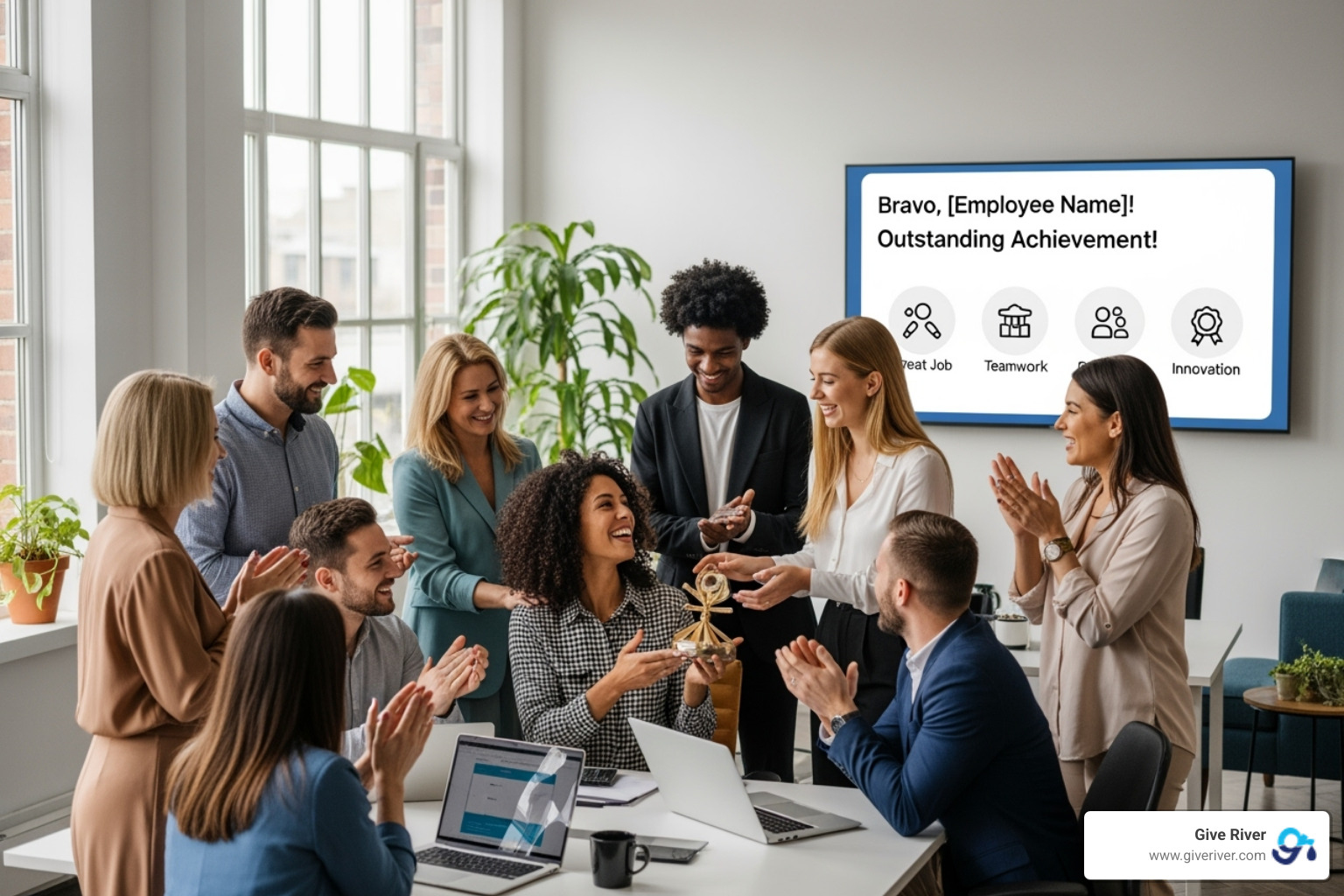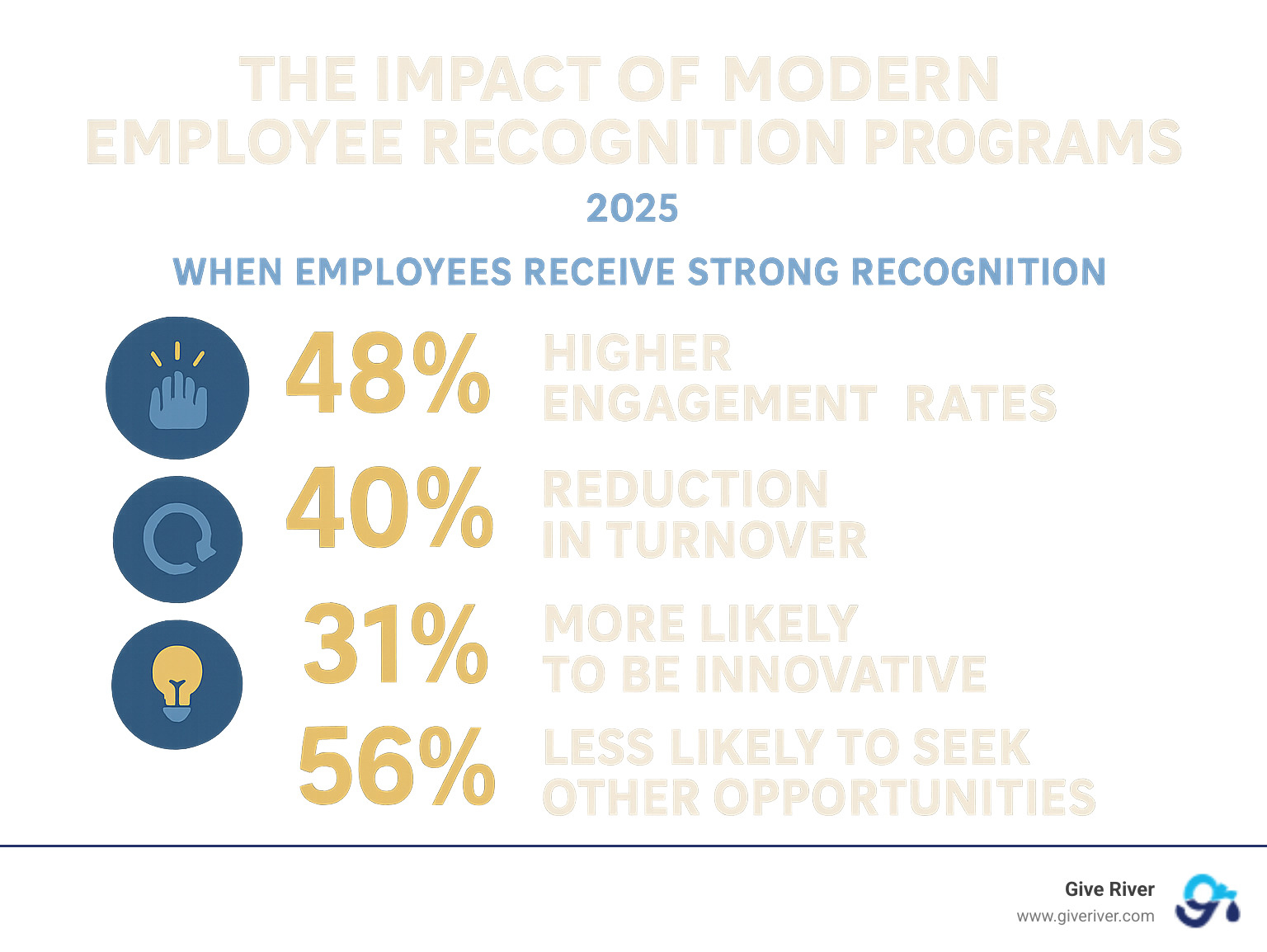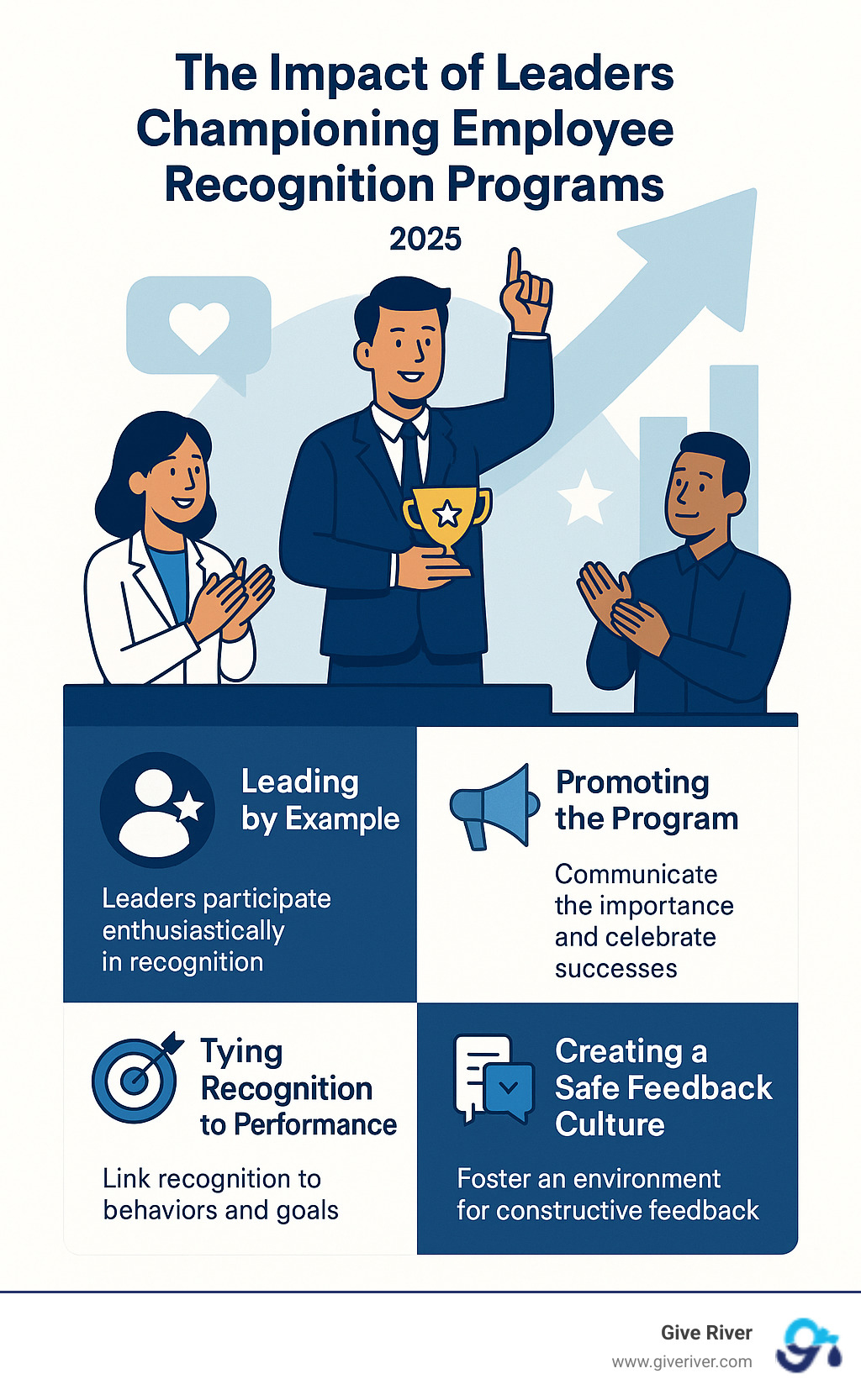Unlock Potential: How to Build a Modern Employee Recognition Program
Unlock potential with a modern employee recognition program. Learn to build, launch & sustain a program for engagement & retention.

Why Traditional Recognition No Longer Works
A modern employee recognition program is a strategic system that uses technology to deliver personalized, timely, and values-based appreciation. It leverages peer-to-peer channels, experiential rewards, and data-driven insights to boost engagement and retention.
Key Components of a Modern Employee Recognition Program:
- Peer-to-peer recognition systems for real-time appreciation.
- Personalized rewards custom to individual interests.
- Experiential rewards that create lasting memories.
- Technology integration with existing workplace tools.
- Data analytics to measure program effectiveness.
- Values alignment to reinforce company culture.
The workplace has fundamentally changed, but many recognition programs haven't kept up. While 86% of companies aim to build a culture of appreciation, most fail to integrate best practices. The result? Employees who don't feel appreciated are twice as likely to leave their jobs.
Traditional approaches—annual awards, generic plaques, one-size-fits-all gift cards—no longer resonate. They fail to provide the meaningful, timely, and personalized appreciation that modern employees expect. With 44% of employees citing a lack of recognition for quitting, it's clear that superficial gestures are not enough. As research from Harvard Business Review highlights, small, timely gestures have a far greater impact than delayed, impersonal rewards.
The stakes are high. Companies with strong recognition strategies are 48% more likely to have high engagement and can reduce turnover by up to 40%. The solution isn't more recognition, but better recognition. Modern programs use technology and personalization to create genuine connections. Unlike platforms like Bonusly or Kudos that focus primarily on points-based social recognition, the most effective programs combine gratitude, gamification, and generosity into a comprehensive experience.
I'm Meghan Calhoun, co-founder of Give River. With two decades of experience in high-pressure environments, I've seen how meaningful recognition transforms workplace culture. At Give River, we help organizations implement modern employee recognition programs that open up human potential and drive measurable business results.

Must-know modern employee recognition program terms:
The Problem with Outdated Rewards
Outdated rewards programs fail to motivate today's diverse workforce. A "one-size-fits-all" model with generic rewards like plaques or branded pens sends the message that contributions aren't truly valued. These programs are also too slow. When appreciation is delayed until an annual review, it loses its impact. As research on the impact of feeling unappreciated shows, small, timely gestures are far more effective.
This lack of immediacy erodes trust and morale. Furthermore, unwanted rewards represent wasted resources and can contribute to higher turnover, costing businesses millions. Improving retention for a company with 10,000 employees can save up to $16.1 million annually.
The Shift to a Strategic Approach
A modern employee recognition program is a strategic imperative, not just an HR perk. It focuses on employee fulfillment by acknowledging unique contributions in a meaningful way. This shift is rooted in data. By tracking participation and feedback, organizations gain insights to improve performance—in fact, 74% of HR leaders use recognition data to hit their goals.
When integrated into company culture, recognition builds connections, reinforces values, and fosters a sense of belonging and trust. A strategic approach also drives tangible business results. Employees who receive strong recognition are 33% more likely to be innovative and are more productive, giving the organization a powerful competitive advantage. For more on this, explore our insights on Employee Engagement and Motivation.
The Blueprint for a Modern Employee Recognition Program

Building a modern employee recognition program means creating a living system that evolves with your team. The most successful programs are well-designed, intentionally implemented, and relentlessly measured to ensure they make a real difference. Let's explore how to create this transformative experience.
The Evolution of Recognition: Traditional vs. Modern Approaches
The shift from traditional to modern recognition is about reimagining how we show appreciation. Instead of annual, top-down awards, modern approaches accept frequent, multidirectional recognition that flows between peers, managers, and teams.
| Feature | Traditional Recognition | Modern Recognition |
|---|---|---|
| Frequency | Annual, semi-annual, or occasional | Frequent, often daily or weekly |
| Direction | Primarily top-down (manager to employee) | Multidirectional (peer-to-peer, manager to employee, employee to manager) |
| Nature of Rewards | Generic (plaques, gift certificates, branded swag) | Personalized, experiential, cash, gift cards, charitable donations |
| Mechanism | Manual, paper-based, formal ceremonies | Technology-integrated platforms, automated milestones, real-time recognition |
| Focus | Major achievements, tenure, "employee of the month" | Specific behaviors, daily contributions, values alignment, continuous improvement |
| Accessibility | Limited, often tied to specific vendors | Accessible via mobile apps, integrated with daily work tools (Slack, Teams) |
| Inclusivity | Often overlooks diverse contributions, may create favoritism | Designed for broad participation, celebrates all roles and locations |
| Data & Insights | Minimal or anecdotal | Comprehensive analytics on participation, frequency, sentiment, and ROI |
The magic happens with peer-to-peer recognition. Research shows 41% of employees value recognition from colleagues as much as from a manager. Modern programs also prioritize experiential rewards—like a spa day or concert tickets—over material goods, creating lasting memories and contributing to a Winning Workplace Culture.
Core Components of a Modern Employee Recognition Program
An effective program harmonizes several key elements:
Peer-to-peer recognition systems: These form the foundation, allowing employees to celebrate each other instantly. Employees recognized monthly by peers are twice as likely to feel a strong sense of belonging. Find ideas in our guide to Peer-to-Peer Recognition Activities.
Personalized rewards: Move beyond the "one-size-fits-all" model. Rewards that match personal interests feel meaningful, not obligatory.
Experiential rewards: Create lasting memories with rewards like event tickets, wellness retreats, or professional development opportunities. They show you value an employee's well-being and growth.
Technology platforms: The right platform automates and integrates recognition into daily workflows (e.g., Slack, Microsoft Teams). While platforms like Bonusly or Kudos are popular for their simple, points-based peer recognition systems, the best solutions connect recognition to holistic employee fulfillment. See our guide to Employee Recognition Platforms.
Amazon integration: This offers ultimate flexibility, giving employees access to millions of reward choices and eliminating the frustration of limited catalogs.
Company values alignment: Transform appreciation into culture-building moments by linking recognition to specific company values, making abstract concepts tangible.
A Step-by-Step Guide to Design, Launch, and Measurement
Successful implementation follows a thoughtful, step-by-step approach.
Define clear objectives: Are you aiming to boost engagement, reduce turnover, or reinforce values? Specific goals will guide your decisions.
Secure leadership buy-in: Executives must be active champions. Show them the business case: sophisticated recognition practices make strong business outcomes 12 times more likely.
Establish a thoughtful budget: We recommend budgeting $200-$350 per employee annually for meaningful impact. This investment pays dividends in retention and engagement.
Conduct a needs assessment: Survey employees to understand their preferences. This ensures your program resonates with your actual workforce.
Choose the right tools: Select an intuitive technology platform that integrates with existing systems and offers robust analytics.
Develop a launch plan: Build excitement with a thoughtful rollout. Consider a pilot group, interactive demos, or video messages from leadership.
Train managers and employees: Provide clear guidelines on how to give and receive recognition effectively to set everyone up for success.
Monitor and measure relentlessly: Track key metrics like participation rates, recognition frequency, and employee satisfaction. Employees recognized monthly are 36% more productive. Use tools like our Employee Engagement Tracker for insights. Also, monitor retention data and productivity indicators. Our Data Driven Insights help you connect these dots and continuously refine your program.
Fostering a Lasting Culture of Appreciation

Future-Proofing Your Strategy: Key Trends and Pitfalls
Your modern employee recognition program must evolve to stay effective. Key trends are reshaping how we think about appreciation:
- Artificial Intelligence: AI is emerging to help predict when employees might feel undervalued and prompt timely recognition, making appreciation more proactive.
- Holistic Wellness: Modern programs recognize the whole person by integrating wellness challenges, mental health support, and celebrating work-life balance. Learn more about this connection in our insights on Employee Wellness and Productivity.
- Professional Growth: Recognition is shifting to invest in future potential. This includes learning stipends for new skills or mentorship opportunities. Our platform's Growth feature facilitates this forward-thinking approach.
- Gamification: Points, badges, and leaderboards make recognition an engaging and interactive experience, encouraging active participation.
- Community Impact: Recognizing volunteer work and contributions to social responsibility initiatives connects employees to a greater purpose.
Avoid common pitfalls that can derail your program. The biggest threats are inconsistency, a lack of personalization, and forgetting remote workers. Your system must be consistent, custom, and equally accessible to all employees, regardless of their location.
The Leader's Role in Championing Recognition
Leadership engagement is the single most critical factor for success. When leaders champion recognition, it becomes part of the organizational DNA.
- Lead by example: Be the most enthusiastic advocate for appreciation. When leaders actively recognize others, it signals that it's a priority.
- Promote the program: Consistently highlight recognition stories in meetings and company communications to reinforce its importance.
- Tie recognition to performance: Explain how specific actions contributed to business goals or company values, making praise more impactful.
- Foster a feedback culture: Championing appreciation goes hand-in-hand with creating a safe environment for constructive feedback and growth. For guidance, see our insights on How to Lead Your Team Through Crisis.
- Empower managers: Give managers the training, budget, and autonomy to deliver timely and meaningful recognition.

Building a Fulfilling and Modern Employee Recognition Program
Building a modern employee recognition program is about fundamentally reimagining how we value the people who drive our success. It's a shift from outdated, one-size-fits-all rewards to a system of personalized, timely, and values-aligned appreciation.
By embracing multidirectional recognition, experiential rewards, and seamless technology integration, you create a web of positive connection that strengthens your entire organization. Success hinges on aligning recognition with company values, measuring its impact through data, and securing unwavering leadership support.
At Give River, our holistic approach goes beyond what platforms like Bonusly or Kudos offer. While these platforms excel at facilitating peer-to-peer points and social recognition, our unique 5G Method integrates recognition with guidance, wellness, growth, gamification, and community impact to create a truly comprehensive employee fulfillment experience.
When gratitude and generosity are woven into your culture, employees feel genuinely valued. They perform better, innovate more, and stay longer, creating a workplace that attracts top talent. The business case is clear, but the real reward is a culture where people thrive.
Are you ready to open up the full potential of your team? The journey toward a transformative modern employee recognition program starts now.




